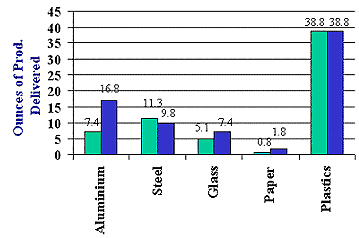 |
| |
Home
:: Myths & Realities |

POINT: Paper and cloth bags
are better alternatives than plastic bags
Counter Point:
- Globally 5th Largest Consumer of Energy
- 10% of All Industry Energy Consumption
- 4% of World Energy Consumption
- One of the Largest Users of Water ü 1 Mt of Paper
(7000 - 8000 copies of News paper) 10 to 17 trees needed
and Paper cannot be recycled indefinitely; Maximum 4
Times.
- Recycling is also energy intensive and requires chemicals
for bleaching / deinking.
- Rated Medium in Biodegradability with Associated Hazards
like leachates.
Paper imposes heavy burden on environment. If we do not
ban paper, why ban plastics?
Source : The World Resources Foundation, UK
POINT: Paper & cloth bags
are better alternatives than plastic bags
Counter Point: Plastics are
100% recyclable via various routes :
- The smaller volume of plastic bags can help conserve
landfill space.
- Nothing degrades fast enough to extend the useful lives
of modern US landfills... not paper, not plastics, nothing.
- 30 percent less material is used to produce today's plastic
bags than the bags made just 5 years ago.
- Compared to paper grocery bags, plastic grocery bags :
- Consume 40 percent less energy than paper (1.34 million
MJ Vs 0.58 million MJ for 1 million bags)
- Generate 80 percent less solid waste
- Produce 70 percent fewer atomospheric emissions
- Release upto 94 percent fewer waterborne wastes.
Source : Dr. William Rathje, University of Arizona Garbage
Project, usa/German federal office.
POINT: Paper & cloth bags
are better alternatives than plastic bags
Counter Point: How eco-friendly
is cotton ?
- Growing Cotton:
- One of the Most Chemical intensive Crops
- Contaminates Intensive use of Soil Fertilizersand Pesticides
- Processing Cotton:
| Bleaching |
- |
Contaminated Effluents |
| Dyeing |
- |
Synthetic dyes not biodegradable, Biodiabolic
|
| Mercerising |
- |
40% remains as waste |
| Anti-felt Finishing |
- |
Heavy metals cr, cu, cd. |
| Water proofing |
- |
Enters the food chain |
| Silk weighing |
- |
Released by clothing when worn |
| 4 Auxiliary Agents |
- |
Absorbed by skin |
| 4 Washing for reuse |
- |
Detergents, Solvents |
When you wear cotton, you also wear Toxins
Source : Statesman
POINT: Paper & cloth bags
are better alternatives than plastic bags
Counter Point:
|
Counter Point
|
How eco-friendly is Jute
?
|
|
RETTING
- Water Pollution
- Air Pollution
-Adverse Effect on Biota
(eg. Fish Culture)
|
- Microbes
- Organic Acids
- Methane Gas
- Hi Water demand |
|
BATCHING
- Use of Batching
|
- Contaminated Product/C Oil
- Odour
- Toxic Effluents
- Not suitable for Food Products
|
|
BLEACHING
- Use of Chemicals
|
- Contaminated Effluent/Water
|
|
AIR POLLUTION
- Particulars/Fiber Dust
- Airborne Toxic Metals
|
- Workers Health
- (Bisniosis) Microbes |
|
Jute processing has adverse impact on environment
POINT: Plastics deplete resources
Counter Point: Plastics Conserve
Resources

Plastic - the most resource efficient packaging material
: highest product - package ratio.
Source : Dr. William Rathje (SPI/APC).
|

